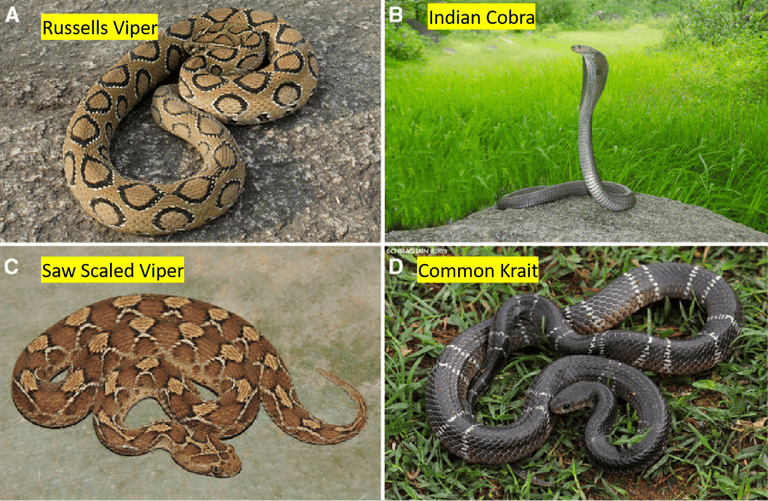Essential Guide to Venomous Snakes in India
There are four types of Venomous snakes observed in India, which should be identified and learn to stay away. Here are the more details. These four snakes also called as Big Four of India
Ganpat Shinde
5/22/20253 min read


India, a land of incredible biodiversity, is also home to a diverse array of snakes, some of which are venomous. While snake bites are a serious concern, understanding these fascinating creatures and adopting simple safety measures can significantly reduce the risk and ensure a safer experience for everyone.
The "Big Four" and Other Notable Species
When we talk about venomous snakes in India, the "Big Four" often come to mind due to their medical significance:
Common Krait : Often nocturnal, krait possess potent neurotoxic venom that can cause paralysis and respiratory failure. They are typically slender and glossy black with white bands.
Indian Cobra : Instantly recognizable by its hood, the cobra's venom is primarily neurotoxic, affecting the nervous system. They are often found near human habitation.
Russell's Viper : This heavy-bodied snake has a distinctive chain-like pattern and its venom is hemotoxic, causing severe tissue damage, bleeding, and organ failure.
Saw-scaled Viper : Small but highly venomous, the saw-scaled viper's hemotoxic venom can lead to severe bleeding disorders. They are often found in dry, sandy, or rocky areas.
Beyond the Big Four, other venomous species like the Hump-nosed Pit Viper and various sea snakes also pose a threat, particularly in specific regions.
Understanding Snake Behavior
Snakes are generally shy and isolated in nature. They prefer to avoid conflict and will usually only bite if they feel threatened, cornered, or surprised. Here are some key behavioral insights:
Night Time Activity: Many venomous snakes, particularly kraits and some vipers, are more active at night.
Camouflage: Their natural coloration provides excellent camouflage, making them difficult to spot.
Warning Signs: Some snakes, like cobras, may display warning signs (like hooding) before striking. Vipers often produce a hissing sound.
Seeking Shelter: Snakes often seek shelter in cool, dark places like under rocks, logs, in dense vegetation, or even within human dwellings during extreme weather.
Essential Safety Tips: Prevention is Key!
The best way to deal with snake bites is to prevent them from happening in the first place.
Be Aware of Your Surroundings:
Watch Your Step: Always look where you are walking, especially in tall grass, dense undergrowth, or rocky areas.
Use a Torch at Night: If you are walking outdoors after dark, always carry a bright flashlight to illuminate your path.
Never Walk Barefoot: Wear sturdy, closed-toe shoes or boots, especially when outdoors.
Avoid Reaching into Blind Spots: Do not put your hands or feet into holes, crevices, or under rocks or logs without checking first.
Around Your Home and Property:
Keep Your Surroundings Tidy: Clear away rubble, woodpiles, leaf litter, and anything that can provide shelter for snakes.
Seal Entry Points: Block any gaps or cracks in your doors, windows, and foundations to prevent snakes from entering your home.
Control Rodent Populations: Snakes are attracted to areas with rodents, their primary food source.
Use Mesh on Drains: Cover drains and pipes with mesh to prevent snakes from entering.
Inspect Before Use: Before sitting on outdoor furniture, using tools, or putting on shoes left outdoors, quickly check them for snakes.
During Outdoor Activities (Hiking, Farming, etc.):
Stick to Clear Paths: When hiking, stay on well-trodden paths and avoid venturing into dense vegetation.
Use a Stick: If you're walking through tall grass or unknown terrain, gently tap the ground ahead with a stick. This can alert any snakes to your presence and give them a chance to move away.
Wear Protective Clothing: In areas known for snakes, consider wearing long trousers and gaiters.
Educate Farm Workers: For those working in agricultural settings, reinforce the importance of vigilance and protective gear.
What to Do in Case of a Snake Bite: Act Fast, Act Smart!
Despite all precautions, snake bites can happen. Knowing what to do (and what not to do) can significantly improve the outcome.
DO:
Stay Calm: Panic can increase heart rate and spread venom more quickly.
Immobilize the Limb: Keep the bitten limb as still as possible, preferably below the level of the heart.
Remove Jewelry/Tight Clothing: Swelling is common, so remove anything that could constrict the limb.
Seek Medical Attention IMMEDIATELY: This is the most crucial step. Get to the nearest hospital or medical facility as quickly as possible. Antivenom is the only effective treatment for venomous snake bites.
Note the Time of Bite: This information is helpful for medical professionals.
DO NOT:
Do NOT Attempt to Suck Out Venom: This is ineffective and can introduce infection.
Do NOT Cut the Bite Area: This can cause further tissue damage and infection.
Do NOT Apply a Tourniquet: This can restrict blood flow and lead to limb damage, and is generally not recommended.
Do NOT Apply Ice or Heat: These are not beneficial and can worsen the situation.
Do NOT Try to Catch or Kill the Snake: This puts you and others at further risk. A description of the snake (color, pattern, size) can be helpful, but your safety is paramount.
Do NOT Rely on Traditional Remedies: While some traditional practices exist, their effectiveness against venom is unproven and delaying medical attention can be fatal.
Coexisting with Snakes
Snakes play a vital role in our ecosystem, helping to control rodent populations. Rather than fearing them, understanding them allows us to coexist safely. By taking proactive steps and knowing how to respond in an emergency, you can minimize the risks and appreciate the natural beauty that surrounds us in India. Stay safe, stay aware!
